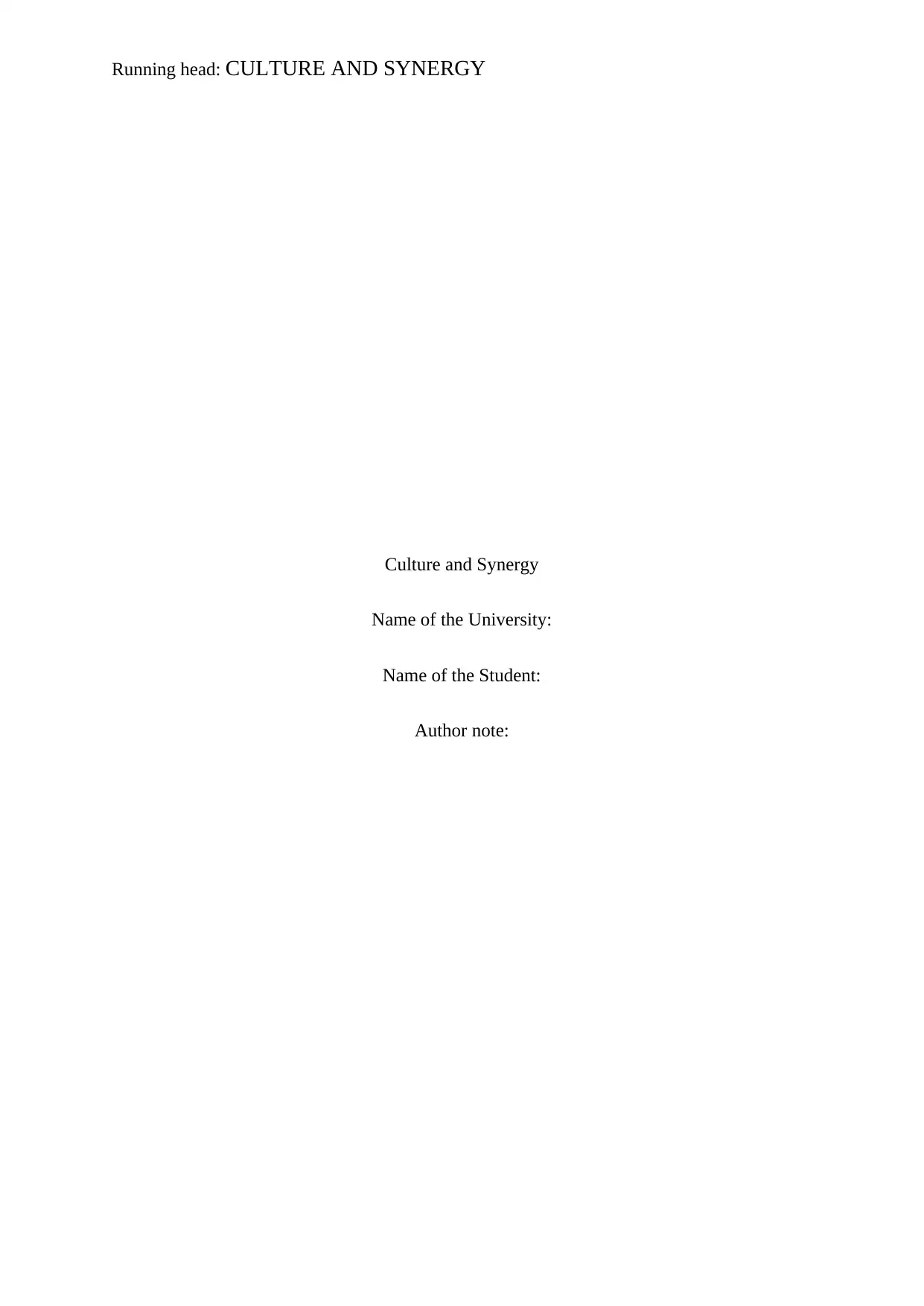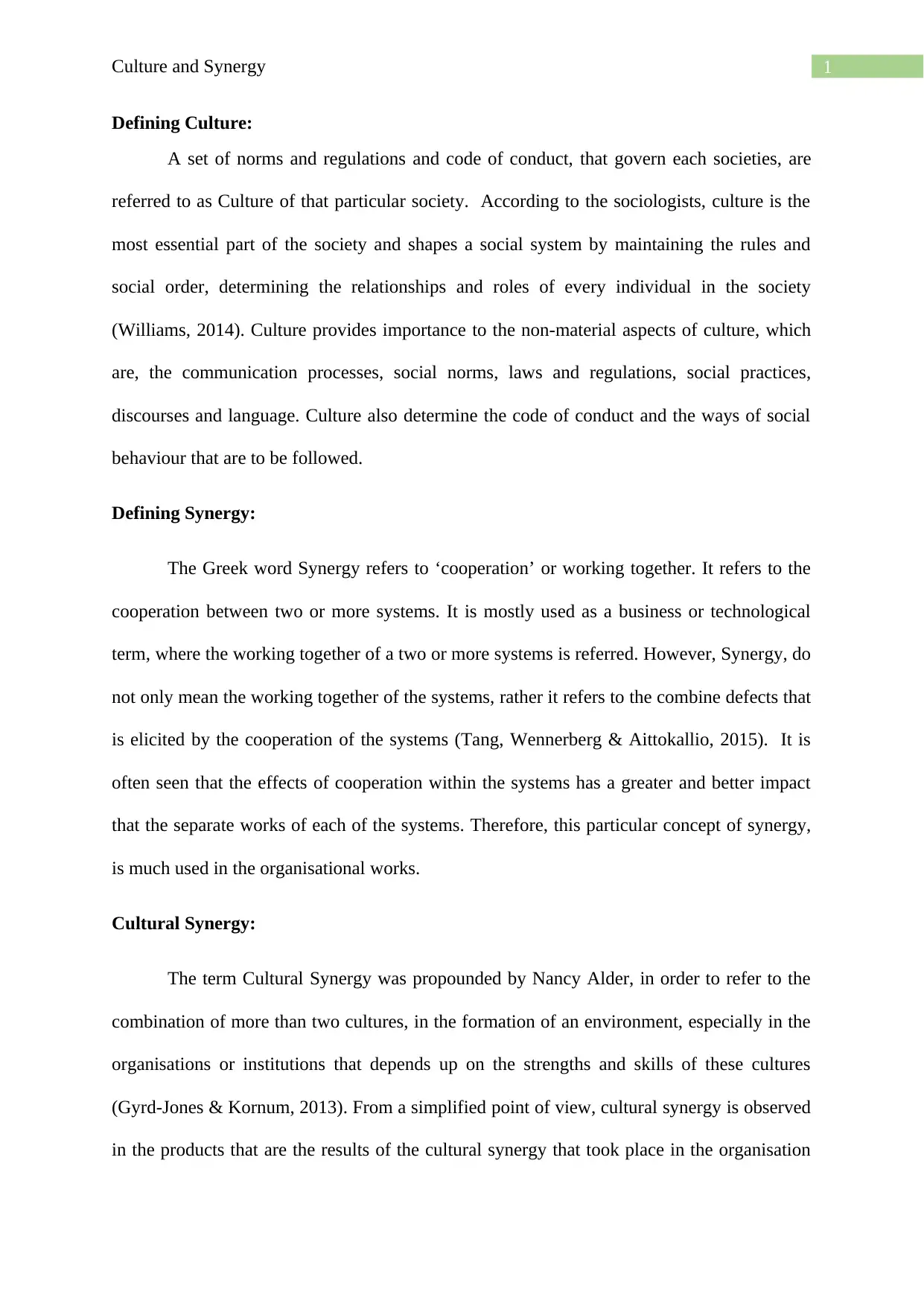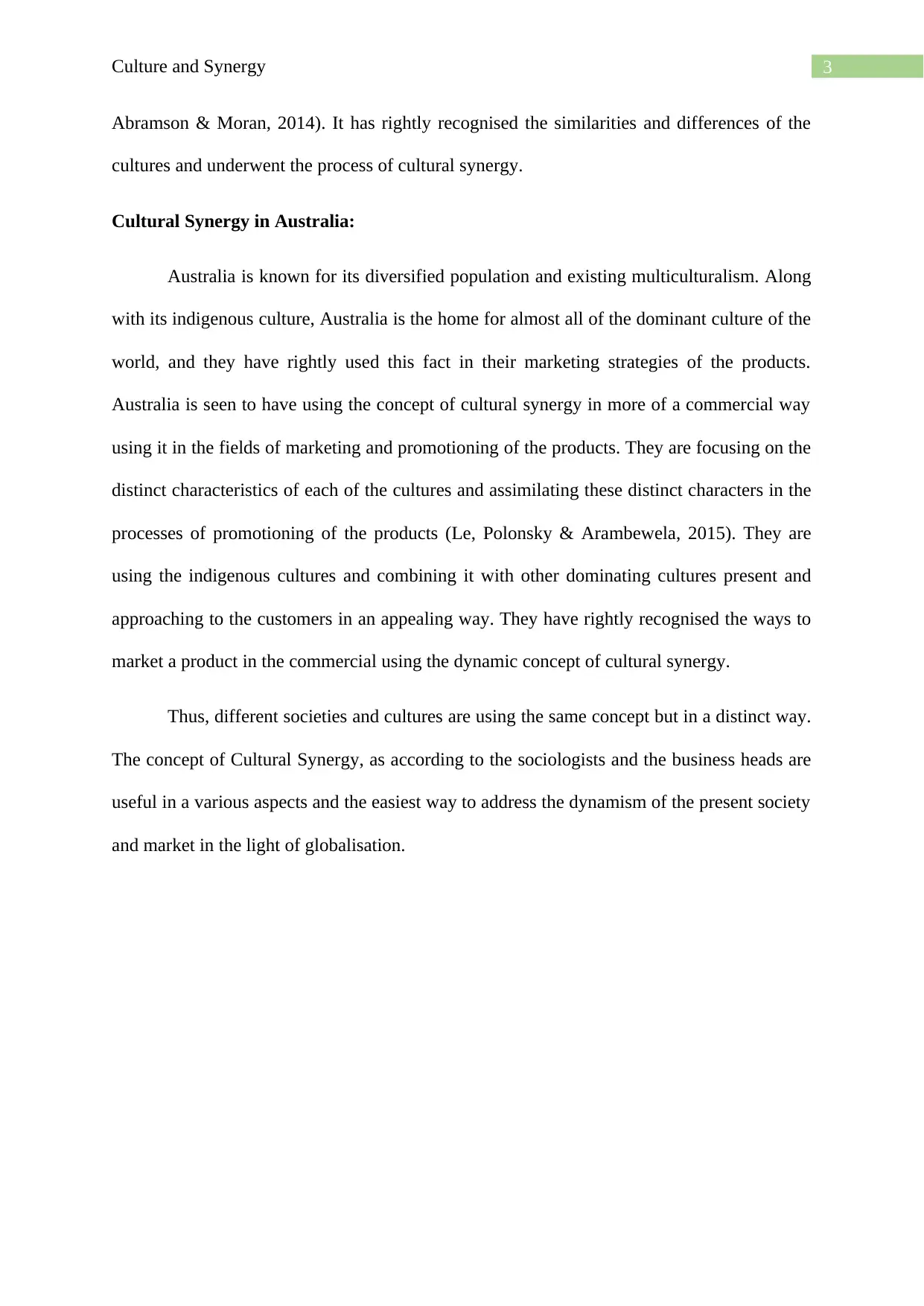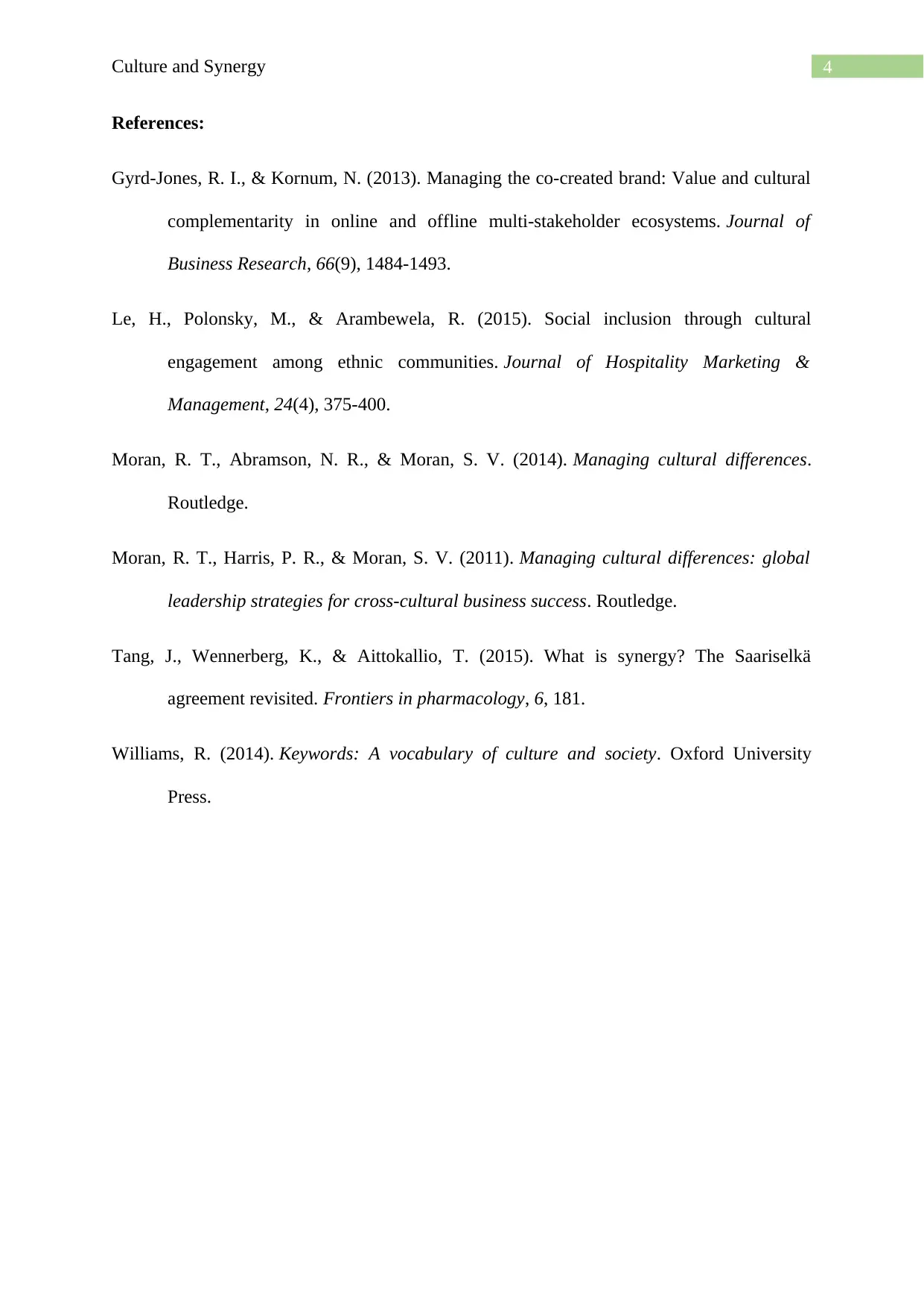Culture and Synergy
VerifiedAdded on 2023/01/23
|5
|1135
|31
AI Summary
This article discusses the concept of culture and synergy, defining culture and synergy, cultural synergy in different societies such as America, Europe, and Australia, and the importance of cultural synergy in addressing the dynamism of the present society and market in the light of globalization.
Contribute Materials
Your contribution can guide someone’s learning journey. Share your
documents today.

Running head: CULTURE AND SYNERGY
Culture and Synergy
Name of the University:
Name of the Student:
Author note:
Culture and Synergy
Name of the University:
Name of the Student:
Author note:
Secure Best Marks with AI Grader
Need help grading? Try our AI Grader for instant feedback on your assignments.

1Culture and Synergy
Defining Culture:
A set of norms and regulations and code of conduct, that govern each societies, are
referred to as Culture of that particular society. According to the sociologists, culture is the
most essential part of the society and shapes a social system by maintaining the rules and
social order, determining the relationships and roles of every individual in the society
(Williams, 2014). Culture provides importance to the non-material aspects of culture, which
are, the communication processes, social norms, laws and regulations, social practices,
discourses and language. Culture also determine the code of conduct and the ways of social
behaviour that are to be followed.
Defining Synergy:
The Greek word Synergy refers to ‘cooperation’ or working together. It refers to the
cooperation between two or more systems. It is mostly used as a business or technological
term, where the working together of a two or more systems is referred. However, Synergy, do
not only mean the working together of the systems, rather it refers to the combine defects that
is elicited by the cooperation of the systems (Tang, Wennerberg & Aittokallio, 2015). It is
often seen that the effects of cooperation within the systems has a greater and better impact
that the separate works of each of the systems. Therefore, this particular concept of synergy,
is much used in the organisational works.
Cultural Synergy:
The term Cultural Synergy was propounded by Nancy Alder, in order to refer to the
combination of more than two cultures, in the formation of an environment, especially in the
organisations or institutions that depends up on the strengths and skills of these cultures
(Gyrd-Jones & Kornum, 2013). From a simplified point of view, cultural synergy is observed
in the products that are the results of the cultural synergy that took place in the organisation
Defining Culture:
A set of norms and regulations and code of conduct, that govern each societies, are
referred to as Culture of that particular society. According to the sociologists, culture is the
most essential part of the society and shapes a social system by maintaining the rules and
social order, determining the relationships and roles of every individual in the society
(Williams, 2014). Culture provides importance to the non-material aspects of culture, which
are, the communication processes, social norms, laws and regulations, social practices,
discourses and language. Culture also determine the code of conduct and the ways of social
behaviour that are to be followed.
Defining Synergy:
The Greek word Synergy refers to ‘cooperation’ or working together. It refers to the
cooperation between two or more systems. It is mostly used as a business or technological
term, where the working together of a two or more systems is referred. However, Synergy, do
not only mean the working together of the systems, rather it refers to the combine defects that
is elicited by the cooperation of the systems (Tang, Wennerberg & Aittokallio, 2015). It is
often seen that the effects of cooperation within the systems has a greater and better impact
that the separate works of each of the systems. Therefore, this particular concept of synergy,
is much used in the organisational works.
Cultural Synergy:
The term Cultural Synergy was propounded by Nancy Alder, in order to refer to the
combination of more than two cultures, in the formation of an environment, especially in the
organisations or institutions that depends up on the strengths and skills of these cultures
(Gyrd-Jones & Kornum, 2013). From a simplified point of view, cultural synergy is observed
in the products that are the results of the cultural synergy that took place in the organisation

2Culture and Synergy
and these products of cultural synergy is distinct and different from the cultures of their
origin. Cultural synergy encourages growth in the organisations. It is often seen that the
products of cultural synergy are always better than the product of their culture of origin.
However, with the onset of Globalisation, the practice of cultural synergy in organisations,
institutions and societies have increased. It is especially true for the business houses, where
the usage of cultural synergy is the most.
Cultural Synergy in America:
The American organisations are seen to have been using the concept cultural synergy
rigorously, in order to address the increasing cultural diversity in the organisations. Moran et
al., (2011), opined that the dynamic approaches of cultural diversity are required to deal from
cultural point of view and the practice of cultural synergy rightly addresses the issues related
to cultural diversity. The American organisations are seen to have been including and
approaching to the organisational structures, policies, procedures, and financial activities all
under the umbrella term of cultural diversity and approaches to the issues with an approach of
cultural synergy.
Cultural Synergy in Europe:
The European countries have used the concept of Cultural Synergy in the social
aspects. The creation of European Territory, is the outcome of the practice of cultural
synergy. Initially, the creation of European Union started with the approach of the
multinational entities trying to unify their economic efforts, and eventually, established a
system of economic and monetary union. The country further, applied the concept in
maintaining the country’s indigenous culture as well as recognising the cultures of the people
from other cultures and countries thus maintaining a cultural equality on the country (Moran,
and these products of cultural synergy is distinct and different from the cultures of their
origin. Cultural synergy encourages growth in the organisations. It is often seen that the
products of cultural synergy are always better than the product of their culture of origin.
However, with the onset of Globalisation, the practice of cultural synergy in organisations,
institutions and societies have increased. It is especially true for the business houses, where
the usage of cultural synergy is the most.
Cultural Synergy in America:
The American organisations are seen to have been using the concept cultural synergy
rigorously, in order to address the increasing cultural diversity in the organisations. Moran et
al., (2011), opined that the dynamic approaches of cultural diversity are required to deal from
cultural point of view and the practice of cultural synergy rightly addresses the issues related
to cultural diversity. The American organisations are seen to have been including and
approaching to the organisational structures, policies, procedures, and financial activities all
under the umbrella term of cultural diversity and approaches to the issues with an approach of
cultural synergy.
Cultural Synergy in Europe:
The European countries have used the concept of Cultural Synergy in the social
aspects. The creation of European Territory, is the outcome of the practice of cultural
synergy. Initially, the creation of European Union started with the approach of the
multinational entities trying to unify their economic efforts, and eventually, established a
system of economic and monetary union. The country further, applied the concept in
maintaining the country’s indigenous culture as well as recognising the cultures of the people
from other cultures and countries thus maintaining a cultural equality on the country (Moran,

3Culture and Synergy
Abramson & Moran, 2014). It has rightly recognised the similarities and differences of the
cultures and underwent the process of cultural synergy.
Cultural Synergy in Australia:
Australia is known for its diversified population and existing multiculturalism. Along
with its indigenous culture, Australia is the home for almost all of the dominant culture of the
world, and they have rightly used this fact in their marketing strategies of the products.
Australia is seen to have using the concept of cultural synergy in more of a commercial way
using it in the fields of marketing and promotioning of the products. They are focusing on the
distinct characteristics of each of the cultures and assimilating these distinct characters in the
processes of promotioning of the products (Le, Polonsky & Arambewela, 2015). They are
using the indigenous cultures and combining it with other dominating cultures present and
approaching to the customers in an appealing way. They have rightly recognised the ways to
market a product in the commercial using the dynamic concept of cultural synergy.
Thus, different societies and cultures are using the same concept but in a distinct way.
The concept of Cultural Synergy, as according to the sociologists and the business heads are
useful in a various aspects and the easiest way to address the dynamism of the present society
and market in the light of globalisation.
Abramson & Moran, 2014). It has rightly recognised the similarities and differences of the
cultures and underwent the process of cultural synergy.
Cultural Synergy in Australia:
Australia is known for its diversified population and existing multiculturalism. Along
with its indigenous culture, Australia is the home for almost all of the dominant culture of the
world, and they have rightly used this fact in their marketing strategies of the products.
Australia is seen to have using the concept of cultural synergy in more of a commercial way
using it in the fields of marketing and promotioning of the products. They are focusing on the
distinct characteristics of each of the cultures and assimilating these distinct characters in the
processes of promotioning of the products (Le, Polonsky & Arambewela, 2015). They are
using the indigenous cultures and combining it with other dominating cultures present and
approaching to the customers in an appealing way. They have rightly recognised the ways to
market a product in the commercial using the dynamic concept of cultural synergy.
Thus, different societies and cultures are using the same concept but in a distinct way.
The concept of Cultural Synergy, as according to the sociologists and the business heads are
useful in a various aspects and the easiest way to address the dynamism of the present society
and market in the light of globalisation.
Paraphrase This Document
Need a fresh take? Get an instant paraphrase of this document with our AI Paraphraser

4Culture and Synergy
References:
Gyrd-Jones, R. I., & Kornum, N. (2013). Managing the co-created brand: Value and cultural
complementarity in online and offline multi‐stakeholder ecosystems. Journal of
Business Research, 66(9), 1484-1493.
Le, H., Polonsky, M., & Arambewela, R. (2015). Social inclusion through cultural
engagement among ethnic communities. Journal of Hospitality Marketing &
Management, 24(4), 375-400.
Moran, R. T., Abramson, N. R., & Moran, S. V. (2014). Managing cultural differences.
Routledge.
Moran, R. T., Harris, P. R., & Moran, S. V. (2011). Managing cultural differences: global
leadership strategies for cross-cultural business success. Routledge.
Tang, J., Wennerberg, K., & Aittokallio, T. (2015). What is synergy? The Saariselkä
agreement revisited. Frontiers in pharmacology, 6, 181.
Williams, R. (2014). Keywords: A vocabulary of culture and society. Oxford University
Press.
References:
Gyrd-Jones, R. I., & Kornum, N. (2013). Managing the co-created brand: Value and cultural
complementarity in online and offline multi‐stakeholder ecosystems. Journal of
Business Research, 66(9), 1484-1493.
Le, H., Polonsky, M., & Arambewela, R. (2015). Social inclusion through cultural
engagement among ethnic communities. Journal of Hospitality Marketing &
Management, 24(4), 375-400.
Moran, R. T., Abramson, N. R., & Moran, S. V. (2014). Managing cultural differences.
Routledge.
Moran, R. T., Harris, P. R., & Moran, S. V. (2011). Managing cultural differences: global
leadership strategies for cross-cultural business success. Routledge.
Tang, J., Wennerberg, K., & Aittokallio, T. (2015). What is synergy? The Saariselkä
agreement revisited. Frontiers in pharmacology, 6, 181.
Williams, R. (2014). Keywords: A vocabulary of culture and society. Oxford University
Press.
1 out of 5
![[object Object]](/_next/static/media/star-bottom.7253800d.svg)





